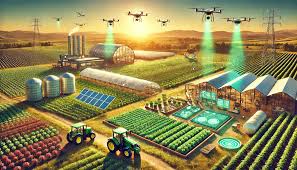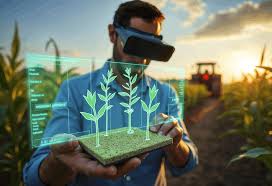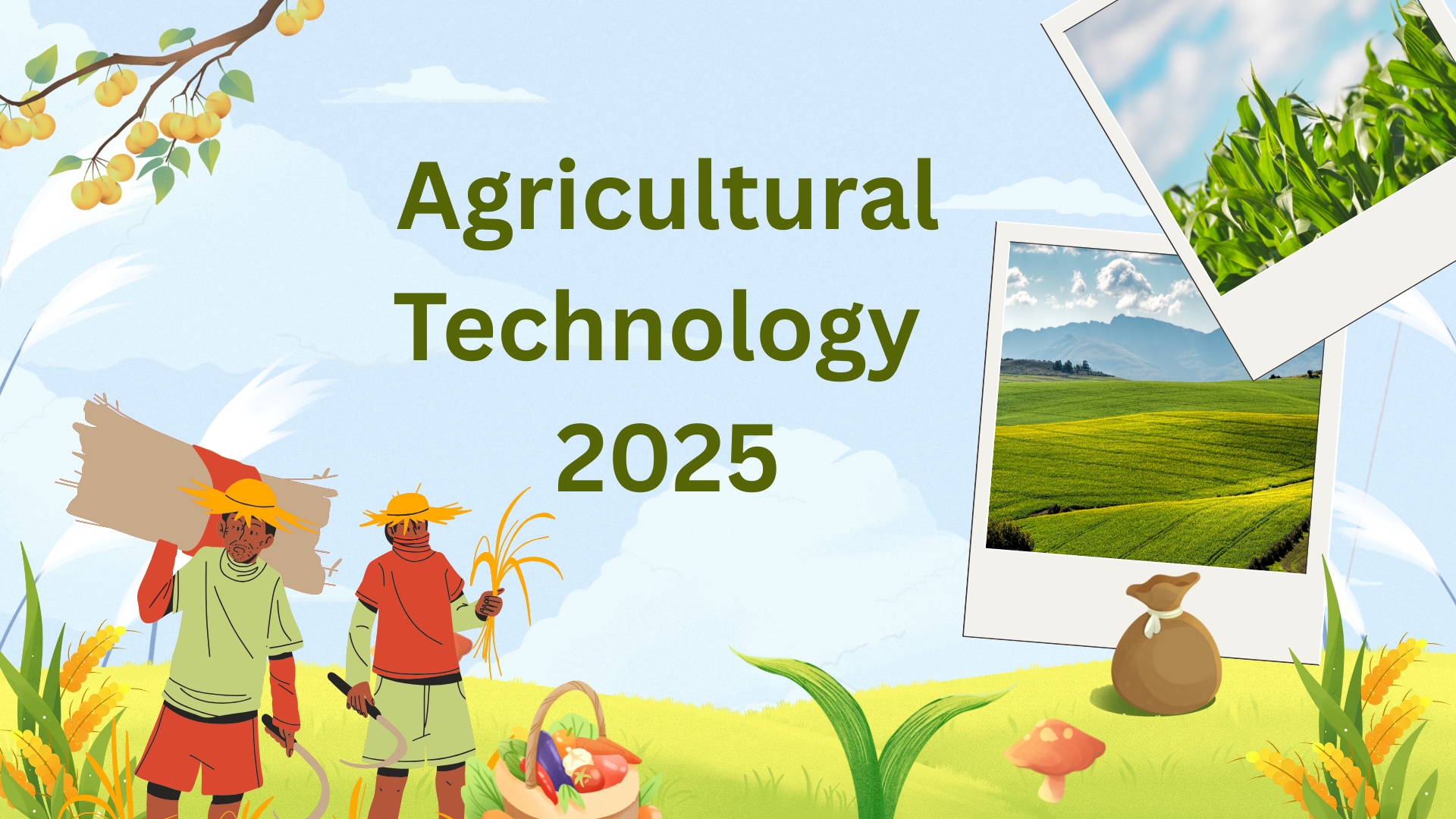Introduction
Imagine this: You’re knee-deep in your backyard vegetable patch on a hot September morning in 2025, or perhaps you’re just browsing TikTok for “easy harvest hacks.” Your phone pings all of a sudden: “Warning! At a cocktail party, your tomatoes are more thirsty than a reality TV star. Water now, or else the drama will wilt.” You laugh, press a button on your agricultural app, and presto! Remote drip irrigation begins.
No more boots covered in mud, no more guesswork. This is the oddball charm of agricultural technology in action, not some dystopian farm movie. Did you know that, just half a decade ago, the global ag tech market was only worth $10 billion, but this year it is expected to reach $22.5 billion? That’s more of a boom than your uncle’s county fair prize pumpkin.
Rewind to my early trips to Grandpa’s farm: While he wrestled a rusty plow that appeared to be allergic to straight lines, we would chase chickens. In the modern era, agricultural technology has completely changed the game. Robots harvest crops with the accuracy of a sushi chef, AI anticipates pest invasions before they ruin the party, and drones scout fields like overzealous scouts.
These days, it’s not just for seasoned farmers; retirees are experimenting with hydroponics for fun, families are cultivating micro-farms on balconies, and children are coding miniature greenhouses. Ag technology isn’t a luxury in a world where food demand is predicted to increase by 50% by 2050; rather, it’s the comical hero that keeps our plates full and prevents the planet from going topsy-turvy.
Come along with me as we cultivate the digital soil: We’ll uncover trends that will make you daydream (sustainable feasts for all) and snort with laughter (like when a drone photobombs a cow). A silver-haired sower, a soccer-mom multitasker, or a toddler with a sprout, agricultural technology is sowing the seeds of wonder. Let’s get started pun intended.
What is Agricultural Technology?
Have you ever questioned whether “agricultural technology” is merely a catchphrase for expensive tractors? Don’t believe it; it’s the secret sauce that uses a wink and a device to turn dirt into dinner. Ag tech’s core goal is to accelerate farming from seed to supermarket by combining brains, bytes, and a little bit of bot magic.
A Simple Breakdown
Agricultural technology, or “ag tech” as hipsters call it, includes everything from blockchain tracking the path of your kale to soil sensors whispering moisture secrets (yes, really). This eco-friendly burrito combines sustainable agricultural innovations, smart farming systems, and precision agriculture tools. With a market value of $22.5 billion in 2025, agricultural technology is surpassing even the fastest-growing crops. Expect 15% yearly growth driven by IoT in agriculture and aspirations for farm automation.

Why It Rocks for Everyone
Agricultural technology: why bother? because dirt time is becoming more accessible. Parents purchase urban farm kits for guilt-free greens, grandparents reminisce while keeping an eye on things through apps, and kids learn to code through robot planters. According to industry statistics, it reduces waste by 30% and increases yields by 20% globally, which translates to more food, less fuss, and fewer “oops, I overwatered” facepalms. In summary, one amusing hack at a time, Ag tech is feeding the world.
Evolution of Ag Tech
Agricultural technology didn’t sprout overnight like a genetically tweaked super-squash. It’s a epic saga from stone-age scratches to satellite-guided sows, dotted with “eureka!” moments and a few epic fails (looking at you, early steam tractors that doubled as crop scorchers).
From Oxen to Algorithms
Go back to 10,000 BCE, when Neolithic people abandoned their hunter-gatherer lifestyle in favor of the plow—ag tech’s common hoe hello. Irrigation canals wind through Mesopotamia by 4000 BCE, transforming deserts into social gatherings. Modern farm automation began in 1831 when Cyrus McCormick invented a mechanical reaper that harvests grain without causing back pain. The 20th century? Fields are now as navigable as your GPS-rerouted road trip thanks to the advent of GPS in the 1990s, after tractors began to rumble in the 1910s.

Milestone Moments
Here’s a quick timeline of agricultural technology high-fives:
- 1700 BC: Windmills – Babylonians grind grain like ancient influencers.
- 1831: Reaper Invention – McCormick’s machine frees farmers from scythe drudgery.
- 1920s: Tractors Boom – Henry Ford’s Fordson makes oxen obsolete (sorry, Bessie).
- 1990s: GPS Precision – Satellites guide tractors straighter than a sober farmer.
- 2010s: Drones Debut – Aerial eyes spot weeds before they weed out profits.
These steps aren’t dusty relics; they’re the roots of today’s smart farming revolution. For a nostalgic nosedive, explore our ag history deep-dive.
Top Ag Tech Trends 2025
2025’s agricultural technology trends are hotter than a jalapeño harvest—think AI outsmarting aphids and robots rustling less than your mischievous pup. With sustainability front and center, these shifts promise bumper crops and lighter carbon footprints.
Precision Ag Takes Center Stage
Precision agriculture, the GPS-wielding wizard of ag tech, is exploding: The market’s eyeing $10.5 billion in 2024 with 11.5% CAGR through 2034. Variable-rate tech doles out seeds, water, and fret like a picky eater’s portions—boosting yields 15% while cutting inputs 20%. Funny? When your field’s “zoned” better than city planners.
AI: The Farm’s New Brain
Artificial intelligence in agricultural technology? It’s like giving crops a crystal ball. AI predicts droughts via satellite data, spotting issues 90% faster than human eyes. In 2025, machine learning crunches big data for pest patrols, with PwC eyeing 25% global productivity pops. Pro tip: Your AI advisor won’t judge your weedy lawn—much.
Check out our 2025 precision ag toolkit for starter tips.
Here’s a snappy table of 2025’s ag tech stars:
| Trend | Key Perk | 2025 Projection |
|---|---|---|
| Precision Ag | 15% yield boost | $10.5B market |
| AI/ML Analytics | 25% productivity gain | 20% adoption rise |
| Drone Surveillance | 30% less chemical use | $5B sector |
| IoT Smart Sensors | Real-time crop health | 18% CAGR |
| Vertical Farming | 90% water savings | $15B urban ag boom |
Drones in Farming: Sky-High Smarts
Drones in agricultural technology? They’re the farm’s feathered spies—buzzing overhead like nosy neighbors with NDVI cameras. No more blind spots; just aerial intel turning guesswork into gridlock mastery.
Spotting Trouble from Above
These winged wonders map fields in multispectral glory, flagging nutrient gaps or fungal foes early. In 2025, AI-piloted drones spray precisely, slashing chemical drift by 30%. Cost? Dropping faster than crop prices—entry models under $1K. Imagine: Your quadcopter catches blight before it bites.
Crop-Saving Shenanigans
Real wins? Brazilian soy farms upped yields 20% via drone scouting, per case studies. And the laughs? Viral vids of drones “herding” escaped livestock—pure gold. For hands-on, our drone farming guide has launch tips.
Smart Farming with IoT
IoT in agriculture? It’s like wiring your veggie patch to the internet—sensors gossip about soil pH while actuators water on whisper. Smart farming via agricultural technology makes fields feel like a chatty neighborhood watch.
Connected Crops Chat Back
IoT devices ping data to apps, optimizing everything from irrigation (saving 20-30% water) to livestock tags tracking moo-ves. 2025 sees 18% CAGR, with billions of connected nodes. Your farm’s now a network, not a nerve-wracker.
Wins, Woes, and Wi-Fi Woes
Pros: Predictive alerts dodge disasters. Cons: Rural dead zones turn tech into tantrums. Humor? Cows “hacking” GPS collars for extra grass. Bridge the gap with our IoT setup for small farms.
Read more: Advancements in Tech Reshaping Agriculture
Vertical Farming: Stack It Up
Vertical farming in agricultural technology? Forget sprawling acres—stack greens in shipping containers or skyscrapers, lit by LEDs like a perpetual rave. It’s urban age’s answer to “where’s my plot?”
City Greens in Skyscrapers
Hydroponic towers yield 10x more per square foot, guzzling 90% less water. In 2025, $15B market eyes Singapore-style sky-farms feeding megacities. Perfect for all ages: Kids sprout basil in basement towers, city dwellers harvest herbs hassle-free.
Green Dreams vs. Reality
Twists? Energy hogs and pricey setups—LEDs munch kilowatts like rabbits on lettuce. But ROI? 30% faster cycles. Chuckle: “Farming on the 50th floor—elevator included!” Dive deeper in our vertical farm starter pack.
Future of Agricultural Technology
Gazing at agricultural technology’s horizon? It’s a sci-fi salad: Gene-edited super-crops, robot swarms, and climate-proof fields. By 2030, ag tech could feed 10 billion without breaking the bank—or the biosphere.
Biotech Bonanza Ahead
CRISPR tweaks drought resistance, while blockchain ensures “farm-to-fork” transparency. Vertical and precision ag hybrids promise 50% waste cuts. For families, app-driven “farm shares” make sustainable ag a screen-tap away.
Bumps in the Dirt Road
Hurdles? Digital divides hit smallholders hardest, and cyber-bugs could crash crop cams. Costs linger, but subsidies help. Witty warning: If robots unionize, who’ll scare the crows? Solutions? Inclusive policies and open-source ag tech. The field’s fertile—let’s sow wisely.
Read more: Technology adoption: What’s on the ag tech horizon for 2025
Summary
We have discovered a wealth of information during our rapid exploration of agricultural technology: These innovations, which range from drones avoiding cow patties to precision ag plotting like a chess master, are cleverly and wisely greening our world. A change is indicated by the $22.5 billion ag tech boom in 2025—yields up, waste down, and fun factored in for each generation. We have marveled at vertical vegetable towers, laughed at IoT tantrums, and charted a biotech future that is both exciting and challenging. A planet where children chase digital butterflies, parents serve pesticide-free meals, and elders pass on plots of progress is what agricultural technology is fundamentally about.
What is emerging in your world, then? Ag tech welcomes everyone to the table, regardless of whether they live on a desk or in the dirt. Do you have a favorite farm failure story or trend? Tell us what you think in the comments section below! If this made you smile, share it; let’s continue the conversation. Are you prepared to sow your first intelligent crop? Grow greener today by obtaining our free ag tech checklist.
Read more: Energy Technology: Powering a Smarter Future 2025
Frequently Asked Questions
What is the latest agricultural technology in 2025?
In 2025, cutting-edge agricultural technology spotlights AI-driven predictive analytics for pest control (90% accuracy) and autonomous robots harvesting delicate fruits with zero bruising. Drone swarms integrate with IoT for real-time field mapping, while vertical farms use LED optimization to yield 10x more in urban spaces—making sustainable, high-output farming accessible to all ages and scales.
How has agricultural technology changed farming?
Agricultural technology has revolutionized farming by mechanizing labor (tractors since 1920s slashed manual work 80%), enabling precision inputs via GPS (20% yield boosts), and fostering smart systems like IoT sensors that cut water use 30%. It shifts from reactive toil to data-driven sustainability, empowering smallholders to global giants alike.
What are examples of agricultural technology?
Key examples include GPS-guided tractors for exact planting, drones scouting crop health via multispectral imaging, and IoT soil sensors auto-adjusting irrigation. Add gene-editing tools like CRISPR for resilient seeds and blockchain for supply traceability—these span precision agriculture to farm automation, enhancing efficiency across diverse operations.
What is the future of agricultural technology?
Ag tech’s future brims with biotech hybrids like CRISPR crops dodging climate woes and robot fleets automating 50% of harvests by 2030. AI will forecast yields with 95% precision, while vertical systems feed cities sustainably. Equity challenges persist, but inclusive innovations promise food security for a 10-billion world.
How does agricultural technology benefit farmers?
It boosts profits via 15-25% higher yields from precision ag, trims costs with 30% less inputs through IoT, and mitigates risks like droughts via AI alerts. For all farmers, from backyard buffs to big ops, it means less grunt work, more green—fostering resilient, eco-smart practices that pay off long-term.

